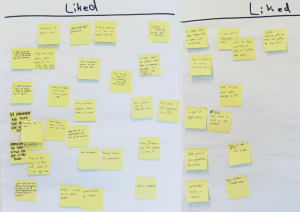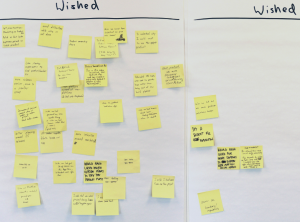This week I facilitated a retrospective for a project that I wasn’t involved with. Immediately after the retro, I asked a few people for their input on how the retro went. One person in specific really enjoyed how I framed and conducted the retro. That person was relieved to participate in a retro that wasn’t dominated by complaints and criticism.
Because of the input I received, I am sharing how I put the retro together with the intent that more people can see what we did during this retro, possibly learn a new/different way to conduct a retro, and to open the door for input from even more people on this style of retro.
Framing:
Framing is important. For this retro, I started by explaining the mechanical things that everyone could expect (ask a question; spend some time writing at least 1 response; read your responses aloud; group similar responses).
I wrote out 3 rules, hung them on the wall, and we discussed them as a group…
- no whining
- be impeccable
- no pooh-poohing
(Yes, I really wrote “pooh-poohing”…it is an ice breaker in addition to being an important part to focus our conversation)
The purpose of this particular retro was to celebrate and retire a product that many of our SEPeers built, meHive. Instead of focusing on process improvements, impediments, and team dynamics, I asked everyone to pretend as if we were consultants for a team that was responsible for building a new product at SEP.
Conducting:
We broke the retro into 3 parts…first question, lunch, second question.
The first question I asked was, “What about the project/product/team did you like?” Again, the framing is important here. You are consulting a different team that is about to build a product…this is your opportunity to share with this team about things you liked when building a product. We spent 5 minutes coming up with things we liked, and we spent about 20 minutes sharing those things aloud.
Breaking for lunch is good because it gave people time to chat, think about the upcoming second question, and fill our bellies with some good food.
The second question I asked was, “What do you wish was different about the project/product/team?” I specifically did not ask what they did not enjoy because that would filter out ideas that we wanted to hear. Instead, we wanted to know (as consultants) what kind of things we could pass on to a team that is about to build a new product. That could be things that were there in the previous project, that ended up hindering the team…or it could be things that were not present that they wished were present.
Wrapping up:
The action item for each person was to find ways (again, as consultants to another team) to share these lessons with the intent of leveling up more people than just were on the team.
Again, this retro was different because we focused on acting as consultants for a future product team. You might find this style of retro useful if you are crossing a significant milestone with your team.

